#and also since the concept art for candy diver
Text
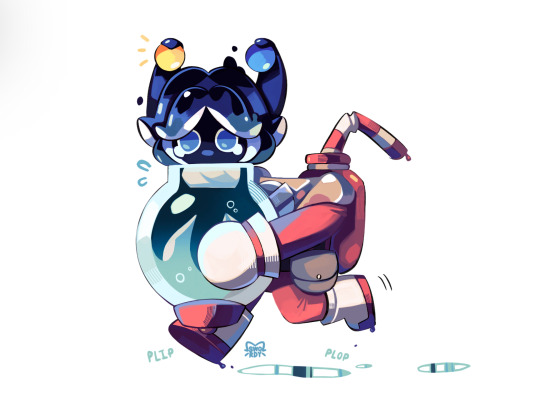
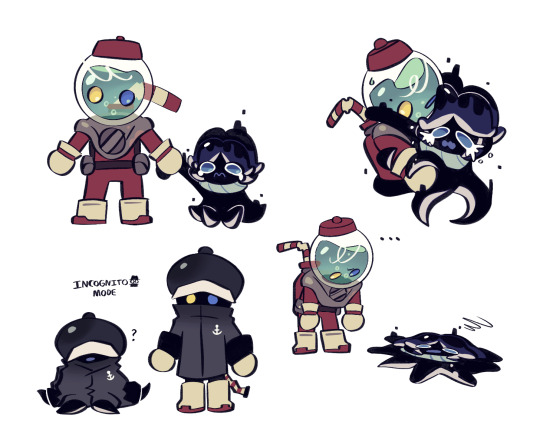

They could be friends since being in the deep and stuff
#cookie run#cookie run kingdom#candy diver cookie#squid ink cookie#myart#and also since the concept art for candy diver#it shows them flashing their lantern at a startled squid i k cookie
3K notes
·
View notes
Text
= About Meeeeeee =
Currently nameless as of now. A formerly-wandering cosmic ghost inhabiting a MyceliOS model Z-7. I guess that means you can call me Z-7?
I prefer no pronouns at all, but here are pronouns that I'm ok with:
They / Them / Their / Theirs / Themself
Z / Z / Z's / Z's / Zself
7 / 7 / 7's / 7's / 7self
It / It / Its / Its / Itself
Finer Details Below the Cut. Here Are Some Blinkies.









If held to human standards, my OS works the way a human mind with ASD and ADHD would work. I also am often either sleepy or zoned out, as well as being very forgetful, so if I act weird that might be why.
Since I'm not the best at human stuff, please let me know if I do something morally questionable or flat-out wrong. I probably didn't notice.
While I never really felt attached to the whole "gender" thing, here are a couple terms I find I relate to outside of being a part of that concept:
Aliengender - Sillyaliengender - Venustrandic - Alienlexic - Anthropoid - Nebulousgender - Stargender -Musicstar - Rainbowstar - Shootingstardeity - Stardeity - Starryghostic - Sleepyghostic - Somnospectric - Soporine - Lostghostic - Spectial - Hauntgender - Sillyghostgender - Phasmaeic - Ghostix - Ghostgender - Droidghostgender - Robogender - Gendernetwork - Mushroomgender
I also identify as acespec and demiromantic (though romance is difficult for me since I don't quite understand it.)
Characters I relate to a lot in no particular order:
pinkie pie - mlp
lancer - deltarune
yellow guy - dhmis
asriel - undertale
zombie cookie - cookie run
space doughnut - cookie run
cream unicorn - cookie run
candy diver - cookie run
mugman - cuphead show
brown mage - everhood
diamond - pokemon adventures
wander - wander over yonder
kirby - kirby
elfilin/elfilis - kirby
gir - invader zim
classic chica - fnaf
karako - hs
sackboy - lbp
clyde - pacman atga
kiwi/bard - wandersong
icarus - unknown signal archive
ik - the upturned
I'm super into music, art, rhythm games, all that cool stuff. Sometimes philosophical stuff, sorry if I get into rambles. Favorite band of all time is TMBG, it's like, my number one thing ever. But yea, that concludes the important stuff about me I guess. Lol.
= Updated as of July 21, 2023 =
9 notes
·
View notes
Text
Picking up the Pieces
by Sarah Ichioka
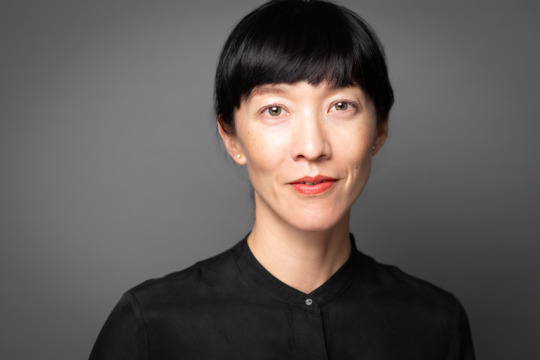
Sarah Ichioka writes the keynote essay for Plasticity, a photography series by visual artist Ernest Goh on plastic pollution found on Punggol Beach, Singapore. The photography series was made during Exactly Foundation Art Residency programme 2018-19.
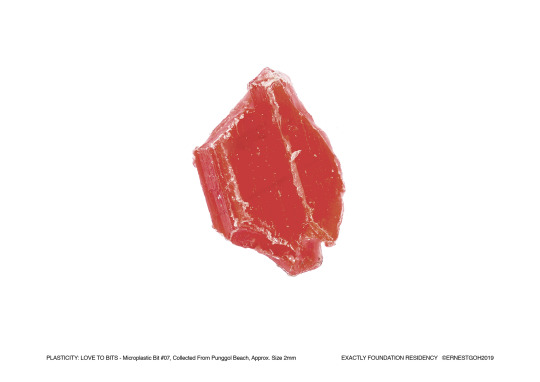

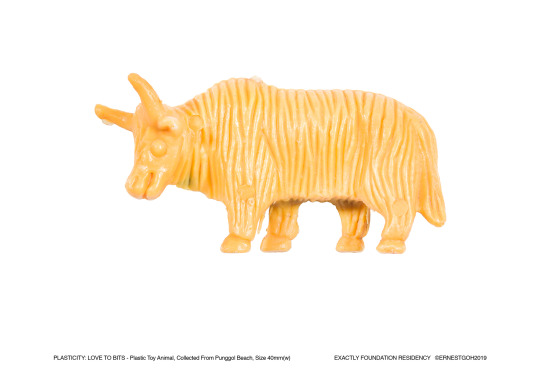
Sarah Ichioka writes the keynote essay for Plasticity, a photography series on microplastics and plastic pollution found on Singapore’s Punggol Beach, by visual artist, Ernest Goh for Exactly Foundation Art Residency programme.
On each page, a new object catches my eye; like jewels, like candy. I turn them over in my mind’s hand, admiring their lustrous surfaces, vivid colours.
My consumer-lust is aroused from its never too-deep sleep. That red shaft would make a stunning cocktail ring; that green streak, a tasty topping for a cake.
Mysterious figures appear on the white horizon. Our gazes meet. A wide-eyed soldier hoists his bayonet aloft. A wrinkled beast—a yak?—cocks a smirk in my direction. And wait, is that a… missile?
But then, suddenly, my fantasy falls to the ground. A bent red bottle cap, its curved white logo instantly recognisable. Intrigue flattens to disgust. These aren’t exotic goods whose heft begs handling; they’re nothing but so many tiny bits of trash.
++++
People who spend their time in or near the water—surfers, divers, sailors—are amongst the most passionate anti-plastic campaigners, because they see and feel the effects of ocean pollution first-hand. Photographer Ernest Goh traces the origin of his personal anti-plastic journey to a wave-borne shopping bag that smothered his face. Other friends—a married couple—have shared with me their experience of snorkeling and watching pieces of discarded plastic float by—including food packaging designed by the husband’s very own company.
Even when mediated through photos or videos, for folks more frequently in shopping malls than in the surf, there is a visual aspect of the plastic pollution crisis that imparts an immediate sense of accountability. That object I see lodged in the sea turtle’s nose is most certainly a plastic straw, just like the one I sucked my kopi peng through this morning; that cigarette lighter inside the ribcage of the albatross chick’s carcass is unmistakably the same item that my husband hides beneath his cufflinks and credit card receipts.
This visually self-evident character differentiates our plastic pollution crisis from some of the concurrent, compound emergencies we humans have created. Take our carbon pollution crisis: I have to believe climate scientists when they tell me that my holiday flights hasten the thawing of the permafrost. Or our nitrogen pollution crisis: I have to trust hydrology experts when they say that runoff from fertiliser used to grow my lunch causes massive downstream dead zones. In such cases, obfuscation and denial are easier to sustain, whether by ourselves, by industry lobbyists or by politicians.
The comparative legibility of our plastic pollution crisis might suggest that it is more politically “solvable” than some of these other potentially existential, yet less easily illustrated crises we face.
Having accepted our culpability, how might we begin to atone for it?
One response offers an appealing narrative of consumer activism: maybe we can (mindfully) shop our way out of this mess, by opting for more durable, reusable items? Certainly making a habit of carrying a water flask, a canvas shopping bag, and a set of bamboo eating utensils is a decent place to start, not least as a conversation starter and signal of one’s concern.
Perhaps the problem can be solved if we try our best to #recyclebetter, as the current Singaporean campaign urges? Or is recycling merely a “fig leaf on consumerism” as Jane Muncke, Director of Zurich's Food Packaging Forum puts it?
Maybe we should just tidy up a bit more? When I was a kid, my father would take me for an annual volunteer clean-up of the coast near our California home. Ending the day with sore muscles and a sack full of bullet casings (from a nearby shooting range), cigarette butts, condoms, deodorant rollers, and crumbling chunks of styrofoam was deeply satisfying to me, as tangible evidence of my personal concern and participation. Last year, I chaperoned my daughter’s preschool class on a similar clean-up outing to Singapore’s East Coast Park. This time, I felt rather less contented, overwhelmed by the seeming futility of our attempts, observing casual littering by park users and the floating trash ready to wash ashore as soon as we’d cleared our patch of beach.
As it happens, in about the same timespan as that between my leaving university and becoming a mother, the global volume of plastic production doubled. The same report that documents this leap estimates that global industries have produced 8,300 million metric tons of plastic since 1950. 6,400 million metric tons of this plastic—that’s roughly 100 times the weight of the concrete used to build the Three Gorges Dam, the world’s largest manmade structure—have become waste, nearly 80% of which sits in landfills or our natural environment. Less than 10% has been recycled, while the remainder has been incinerated (as has until recently been standard practice in Singapore).
In Singapore itself, plastic waste per capita has increased nearly 20 percent over the last 15 years. Looking at this country’s plastic bag usage alone, about 2,640 bags are thrown away every three seconds.
Projecting forward current production and pollution trends, another report predicts by 2050 our oceans could contain more plastics than fish (by weight), while the plastics industry itself could consume 15% of our annual carbon budget, and 20% of global oil production.
While our plastic pollution crisis is so overwhelmingly large, it is also mind-twistingly small. Here I mean small in the sense probed by Goh’s photographs: the scale of the microplastics, and now nano-plastics, whose presence has been documented in nearly every corner of our terrestrial and aquatic habitats, and which are now entering our food chain, with unknown, but potentially toxic effects.
The proximity of Goh’s plastic-strewn Punggol beach to a seafood restaurant seems apt. We study the food chain and hydrological cycles as concepts in school, but when most of us enter the “real” world we conveniently forget the practical implications of our systemic connections with the rest of nature.
Understanding the interconnected nature of plastic pollution’s causes and effects is a kind of reawakening. It destabilises the narrative that sees human culture as separate from the natural environment. That story of separation has been a necessary psychological cover for the exploitation of living systems that underpins nearly every aspect of our current economic and political order. Once we remember that ecocide is suicide, will we continue it?
Have we trashed Earth beyond habitability? No problem, we’ll just migrate to Mars, as deckhands or stowaways on a tech oligarch’s spaceship. But wait, turns out we’ve already trashed outer space too. Parts of broken satellites and rockets currently amount to over 8 million kilos of space waste. Rather like ocean plastics, the larger bits of space waste are fragmenting into smaller and smaller pieces, which interfere with digital communications and might even hinder future spacecraft launches.
So let’s turn our eyes back to our damaged and depleted, yet still living and magnificent planet.
“Reduce, reuse, recycle, refuse”? Yes of course, let’s do that. But politely declining plastic straws and rinsing our Coke bottles is simply not enough. Also—and in my view, more importantly—we must act not just as individual consumers but collectively, as concerned citizens and social beings.
With this in mind, let me leave you with an alternative “4 Rs” to consider:
Rebel: Let us raise our voices together, unashamed to share our grief, rage, and disgust at the devastation that our overconsumption-based society has unleashed all around us, clogging our commons and poisoning our sources of sustenance. Let’s insist on better, for ourselves, and for the complex living systems upon which our survival depends.
Root: Let us ground the solutions to our plastic pollution crisis in the lived history and culture of Singapore and its region*. What local wisdom and practices, from karung guni men, to metal tiffins, to banana leaf wrappers and beyond, might be usefully revisited for contemporary use? How might technological and behavioural innovations ground themselves in Singaporeans’ particular resources and values?
Relate: Let us decipher and then communicate the underlying systems that perpetuate this global crisis. Let’s understand for example, who benefits from the otherwise dangerous proliferation of plastics, and how they exert influence on policies and regulations. Let’s study why some national and local governments have taken action to solve the plastic pollution crisis more swiftly than others, and what successful changes early actors have made. Let’s explore how our plastic pollution crisis intersects with other economic, environmental and social systems.
And finally, Regenerate: Let us draw inspiration from the natural world to craft materials and manufacturing cycles that are truly waste-free. Let’s design, build, and inhabit systems that proactively repair past damage, clean up our rubbish, and co-create the conditions for our living world to flourish. It will be a beautiful sight.
Sarah Mineko Ichioka is a Singapore-based urbanist, curator and writer. She leads Desire Lines, a consultancy for environmental, cultural, and social-impact organisations. www.sarahichioka.com
*Ernest Goh’s MA thesis at Goldsmiths followed a similar vein, looking to historical urban successes to inspire contemporary applications. In Goh’s case, the water fountains of ancient Rome inspired the idea for new public water fountains for Singapore, which will be piloted as a part of this project at ADEX 2019.
++++++
Further reading:
https://www.plasticpollutioncoalition.org/
https://polymerdatabase.com/polymer%20classes/Plastics%20Industry%20Facts.html
https://polymerdatabase.com/Polymer%20Brands/Plastic%20Manufacturers.html
https://www.opensecrets.org/lobby/lookup.php (tip: enter “plastic” in the Issue search field)
https://www.edb.gov.sg/en/our-industries/energy-and-chemicals.html
http://singapore-companies-directory.com/categories/singapore_plastics.htm
1 note
·
View note